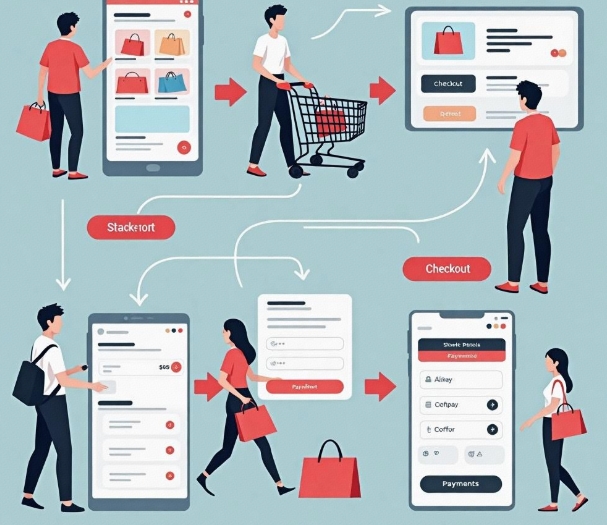Mall Development Process: From Requirements Analysis to Product Launch
- latest articles
- 1.DApp Development & Customization: Merging Diverse Market Needs with User Experience 2.Analysis of the Core Technical System in DApp Project Development 3.How to achieve cross-chain interoperability in Web3 projects? 4.How does the tokenization of points reconstruct the e-commerce ecosystem? 5.How to Set and Track Data Metrics for a Points Mall? 6.What is DApp Development? Core Concepts and Technical Analysis 7.Inventory of commonly used Web3 development tools and usage tips 8.Development of a Distribution System Integrated with Social E-commerce 9.Six Key Steps for Businesses to Build a Points Mall System 10.What is DApp Development? A Comprehensive Guide from Concept to Implementation
- Popular Articles
- 1.Future Trends and Technology Predictions for APP Development in 2025 2.Analysis of the DeFi Ecosystem: How Developers Can Participate in Decentralized Finance Innovation 3.From Zero to One: How PI Mall Revolutionizes the Traditional E-commerce Model 4.DAPP Development | Best Practices for Professional Customization and Rapid Launch 5.Recommended by the Web3 developer community: the most noteworthy forums and resources 6.From Cloud Computing to Computing Power Leasing: Building a Flexible and Scalable Computing Resource Platform 7.How to Develop a Successful Douyin Mini Program: Technical Architecture and Best Practices 8.Shared Bike System APP: The Convenient Choice in the Era of Smart Travel 9.How to Create a Successful Dating App: From Needs Analysis to User Experience Design 10.From Design to Development: The Complete Process of Bringing an APP Idea to Life
With the rapid development of e-commerce, more and more businesses and merchants are turning to online channels. Developing proprietary online stores has become an important strategy for many enterprises to expand their markets and boost sales. Store development is not just a simple technical implementation process; it includes a series of steps from requirements analysis, functional design, front-end development, back-end development, to final launch and operation. This article will detail the entire process of store development, providing an in-depth understanding of each step from requirements analysis to product launch, helping you better grasp the key aspects of store development.
I. Requirements Analysis: Defining Goals and Organizing Functions
The first step in store development is requirements analysis, which is crucial to the success of the entire project. The main tasks of requirements analysis are to clarify the project's goals, determine the store's primary functions, and conduct detailed planning in the early stages of development.
1.1 Defining the Store's Goals and Positioning
Before starting development, it is essential to define the store's goals and market positioning. Is the store targeting general consumers (B2C) or business-to-business transactions (B2B)? Will it sell physical goods or digital products? Does the store need to support multiple languages and regions? The answers to these questions will determine the overall architecture and functional design of the store.
1.2 Organizing Functional Requirements
Based on market positioning and goals, the next step is to outline the store's core functions. Common e-commerce platform features include:
User Management: Registration, login, user permissions, account management, etc.
Product Display: Product categorization, product details, search and filtering, etc.
Shopping Cart and Checkout: Cart management, order management, payment interfaces, etc.
Payment System: Integration of multiple payment methods.
Order Management: Order status tracking, logistics information, after-sales service, etc.
Data Statistics: Sales data, user data, product traffic, etc.
Additionally, determining functional requirements should consider future scalability, such as introducing membership systems, social sharing, marketing campaigns, etc.
1.3 User Experience Design
During the requirements analysis phase, user experience design is also critical. The store's design should be simple, intuitive, and easy to navigate, ensuring users can quickly find the products they need and complete the purchase process smoothly. At this stage, UI/UX designers typically get involved to work on interface design and interaction optimization.

II. System Design: Architecture and Technology Selection
After completing requirements analysis, the project moves into the system design phase. At this stage, the development team needs to perform detailed system architecture design based on the requirements document and functional design, selecting the appropriate technology stack to lay the foundation for subsequent development.
2.1 System Architecture Design
The architecture design of a store system must consider multiple aspects, such as high concurrency, data security, and user privacy protection. Stores typically adopt a layered architecture, including the front-end presentation layer, business logic layer, data storage layer, etc., and require good scalability and high availability design.
2.2 Technology Selection
In terms of technology selection, common technology stacks for store development include:
Front-end: HTML, CSS, JavaScript, React, Vue, etc.
Back-end: Java, Python, PHP, Node.js, etc.
Database: MySQL, PostgreSQL, MongoDB, etc.
Payment Interfaces: Alipay, WeChat Pay, UnionPay, etc.
Cloud Services: AWS, Alibaba Cloud, Tencent Cloud, etc.
Choosing the right technology stack not only impacts development progress but also affects system stability and performance.
2.3 Database Design
A store system requires a well-designed database structure, including product tables, user tables, order tables, payment tables, etc. The relationships between these tables must be clear to ensure data integrity and efficient query performance.
III. Development Phase: Front-end and Back-end Implementation
After system design is completed, the development team enters the actual coding phase. Store development is typically divided into front-end and back-end development.
3.1 Front-end Development
Front-end development is primarily responsible for the store's user interface and interaction design. At this stage, developers need to implement the store's pages based on UI design mockups and ensure the smooth operation of various functional modules. Technologies involved in front-end development include HTML, CSS, JavaScript, React, Vue, etc. Close collaboration with UI designers is essential to ensure the perfect integration of visual effects and interactive experiences.
3.2 Back-end Development
Back-end development is responsible for the store's core logic, database management, and interface integration with the front-end. During back-end development, developers need to implement core business functions such as order processing, payment interface integration, inventory management, and user management, while ensuring system security, stability, and high concurrency handling capabilities.
3.3 Third-Party Interface Integration
Stores often require integration with various third-party services, such as payment interfaces (Alipay, WeChat Pay, etc.), logistics interfaces (courier company APIs), and SMS interfaces. Back-end developers need to interface with these third-party service providers to ensure the completeness and stability of system functions.
IV. Testing and Optimization: Ensuring Store Stability and Smoothness
After development is completed, the project enters the testing phase. The goal of testing is to ensure that every functional module of the store operates correctly, enhancing system stability and smoothness.
4.1 Functional Testing
Functional testing involves a comprehensive check of all store functions to ensure there are no bugs or vulnerabilities. Testers need to simulate user operations, such as registration, login, shopping, and payment, to identify and fix issues promptly.
4.2 Performance Testing
Performance testing evaluates the store's performance under high concurrency conditions, simulating a large number of users accessing the store to check system response speed and stability. The store system must handle high concurrent access without crashing or experiencing slow responses.
4.3 Security Testing
Security testing is a critical step, especially when dealing with sensitive information such as payment details and user data. The development team needs to implement security measures like vulnerability scanning, data encryption, and access control to ensure the system is resistant to attacks and data leaks.
V. Launch and Operation: Post-Launch Monitoring and Maintenance
After store development is completed, the final step is the launch. However, launch is not the end; subsequent operation and maintenance are equally important.
5.1 Launch Preparation
Before launch, the development team needs to perform final checks to ensure all functions are implemented, and the system is stable and secure. The store must be deployed to the production environment, and a final performance test should be conducted to ensure a smooth transition post-launch.
5.2 Monitoring and Maintenance
After the store goes live, the development team needs to continue with operation and maintenance. This includes system monitoring, user feedback collection, issue resolution, and feature updates. The operations team should monitor metrics such as store traffic, conversion rates, and order volumes, adjusting operational strategies as needed.
5.3 Market Promotion
After the store is launched, market promotion is necessary to attract more users to visit and complete purchases. Promotion methods include SEO optimization, social media advertising, email marketing, etc. Additionally, promotional activities and discounts can be used to encourage purchases.
Conclusion
Store development is a complex and systematic process. From requirements analysis to product launch, every step requires careful planning and execution by the development team. Through scientific process management and efficient team collaboration, businesses can successfully launch an e-commerce platform that meets market demands, achieving breakthroughs in online sales and business growth.
The success of a store depends not only on technical implementation but also on a comprehensive consideration of factors such as user experience, system stability, and market strategies. In the future, as technology continues to evolve and market demands change, the development processes and technical solutions for stores will also innovate and improve, helping more businesses succeed in the digital economy era.
-

How does the tokenization of points reconstruct the e-commerce ecosystem?
With the continuous advancement of internet technology and the gradual prolifera···
-

How to Set and Track Data Metrics for a Points Mall?
With the rapid development of the e-commerce industry, points malls, as a common···
-

Development of a Distribution System Integrated with Social E-commerce
With the rapid development of internet technology, the e-commerce industry has e···

 Blockchain
Blockchain











